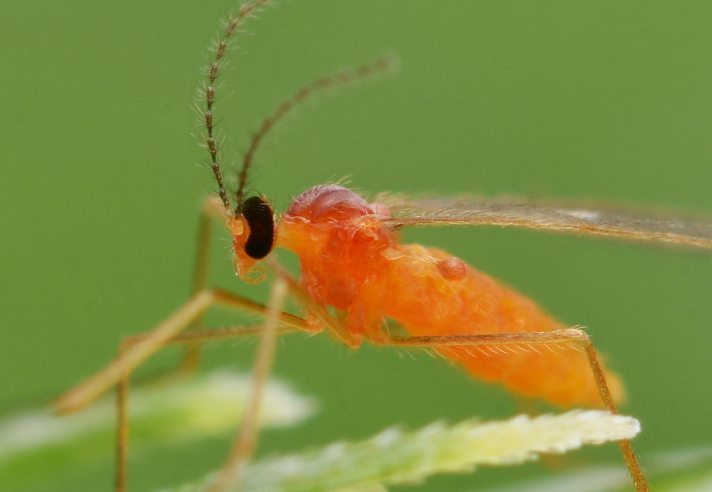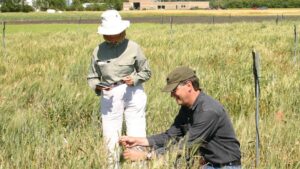Through recent advancements in marker technology, SeCan has just discovered that the majority of the soft white wheat varieties grown in western Canada contain the Sm1 trait for midge tolerance – and for this reason they will require stewardship. The notice below provides the background, an explanation of why stewardship is necessary, and SeCan’s plan to move forward._x000D_
_x000D_
Sm1 was first identified in soft red winter wheat varieties. In the late 1990s Canadian public breeders worked to cross this naturally occurring trait into red spring wheat (CWRS and Extra Strong) for the benefit of western Canadian producers. These first products were launched in spring 2010 (AC® Unity VB, AC® Goodeve VB, AC® Glencross VB). Since that time there have been over 20 varieties of Midge Tolerant Wheat registered in many classes including CWRS, CPSR, CWES, CWAD, and GP/SP._x000D_
_x000D_
As Sm1 products neared commercialization, entomologists agreed that the risk of midge becoming resistant to the trait was highly likely. They suggested a stewardship plan incorporating an interspersed refuge (10% of a susceptible variety) was necessary to preserve the useful life of the Sm1 trait._x000D_
_x000D_
Since the launch of Midge Tolerant Wheat (MTW), researchers have been working to find a marker linked to the Sm1 – so MTW varieties could easily be distinguished from their refuge. Researchers at the Crop Development Centre at the University of Saskatchewan (Dr. Curtis Pozniak, and Ms. Krystalee Wiebe) have been working to perfect a marker for Sm1. This work has provided the opportunity to look at a broader cross section of wheat varieties – and resulted in identifying the Sm1 trait in SWS wheat. In this case it was not intentionally crossed in, but was part of the background of many SWS varieties and AAC Awesome._x000D_
_x000D_
We have confirmed the following SeCan varieties carry Sm1 and are midge tolerant:_x000D_
_x000D_
AAC Awesome (CWSP), AAC Indus, and AC Sadash_x000D_
_x000D_
AAC Paramount has been confirmed by the new marker but needs field confirmation to be 100% sure._x000D_
_x000D_
AC Andrew has been tested by marker and in the field and does not contain Sm1 – for this reason it will be an appropriate refuge for all tolerant varieties._x000D_
_x000D_
Why Stewardship Now?_x000D_
_x000D_
If Sm1 varieties have been grown in other regions without a refuge, why do we need a refuge in western Canada? Other regions (like the UK and eastern USA) do not have a large acreage of wheat in rotation. In western Canada, the traditional fit for soft white spring (SWS) wheat was the irrigation area of southern Alberta – this area typically has little to no midge pressure. However, in the last 7- 8 years, we have seen growth in soft white acres into non-traditional areas – to supply the feed and ethanol market. In comparison to other classes, the SWS acres are relatively small. This is fortunate but still needs to be addressed._x000D_
_x000D_
The fact we have been growing SWS without a refuge puts the Sm1 trait at risk. MTW saves producers 40-60 million dollars per year ($36 per acre). There are no replacement tolerance genes. There is No Plan B._x000D_
_x000D_
For this reason we need to act as quickly as possible to put a stewardship plan in place for the benefit of all wheat producers (not just soft white)._x000D_
_x000D_
The Stewardship Plan:_x000D_
_x000D_
SeCan will add refuge to all future seed stocks released to SeCan members of AAC Awesome, AAC Paramount (once field results confirm resistance), AAC Indus, and AC Sadash._x000D_
_x000D_
Varieties that have not yet been released have limited volumes. Remediation will be a much greater challenge for a variety like AC® Sadash that is currently grown on several hundred thousand acres, making up over half of the total SWS acres._x000D_
_x000D_
For AC Sadash there were two options if the Sm1 is to be protected:_x000D_
_x000D_
1) Work with SeCan members and the industry to add refuge to all seed stocks available – as soon as realistically possible_x000D_
_x000D_
2) Deregister AC Sadash to remove it from the system, and replace it with the new products that have refuge blended in._x000D_
_x000D_
SeCan has decided it is in the best interests of the industry that AC® Sadash remain available – and trust the industry will be willing participate to implement a stewardship plan._x000D_
_x000D_
The hope is that growers will do “what is right” to protect the trait for the benefit of future generations of wheat producers._x000D_
_x000D_
In the near future, we hope to have the marker developed by CDC commercially available – this will give us the opportunity to monitor farm level samples of AC Sadash for the appropriate level of refuge – to ensure the stewardship is being followed.












